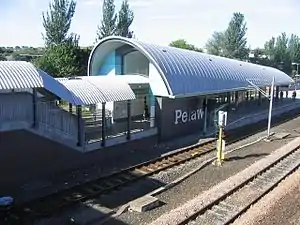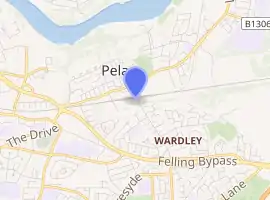Pelaw Metro station
Pelaw is a station on the Tyne and Wear Metro, serving Bill Quay, Pelaw and Wardley in Gateshead. The Tyne and Wear Metro station at Pelaw was opened in September 1985, and refurbished in 2006.
Pelaw | ||||||||||||||||
|---|---|---|---|---|---|---|---|---|---|---|---|---|---|---|---|---|
| Tyne and Wear Metro station | ||||||||||||||||
 | ||||||||||||||||
| Location | Pelaw, Metropolitan Borough of Gateshead England | |||||||||||||||
| Coordinates | 54°57′10″N 1°32′29″W | |||||||||||||||
| Grid reference | NZ294621 | |||||||||||||||
| Transit authority | Tyne and Wear Passenger Transport Executive | |||||||||||||||
| Platforms | 2 | |||||||||||||||
| Tracks | 2 | |||||||||||||||
| Construction | ||||||||||||||||
| Bicycle facilities |
| |||||||||||||||
| Disabled access | Step-free access to platform level | |||||||||||||||
| Other information | ||||||||||||||||
| Station code | PLW | |||||||||||||||
| Fare zone | B | |||||||||||||||
| History | ||||||||||||||||
| Original company | Brandling Junction Railway | |||||||||||||||
| Pre-grouping | North Eastern Railway | |||||||||||||||
| Post-grouping | ||||||||||||||||
| Key dates | ||||||||||||||||
| 23 February 1843 | Opened | |||||||||||||||
| 5 November 1979 | Closed for conversion | |||||||||||||||
| 15 September 1985 | Reopened | |||||||||||||||
| Passengers | ||||||||||||||||
| 2017/18 | 1.09 million[1] | |||||||||||||||
| Services | ||||||||||||||||
| ||||||||||||||||
| Location | ||||||||||||||||

| ||||||||||||||||
Pelaw is a busy interchange, where passengers can change between Green Line services to and from South Hylton & Sunderland, and Yellow Line services to and from South Shields.
Service & Frequency
Pelaw is served by both the Yellow Line (running from South Shields to Newcastle City Centre, Whitley Bay, Wallsend & St. James), and the Green Line (running from South Hylton & Sunderland to Newcastle City Centre, Regent Centre & Newcastle Airport).
Both lines run up to every 12 minutes during the day (Monday to Saturday), and up to every 15 minutes in the evenings and on a Sunday. This allows for a combined service of up to every 6 minutes (Monday to Saturday), and up to every 7–8 minutes during the evening and on a Sunday between Pelaw and South Gosforth.
Additional trains run during the morning and evening peak (Monday to Friday) between Pelaw and Regent Centre or Monkseaton. This provides a Metro up to every 3 minutes between Pelaw and South Gosforth at peak times.
History
Pelaw Metro station is built on the site of a previous main line station, opened by the Brandling Junction Railway in 1843. It became a junction in 1850, when the Newcastle and Darlington Junction Railway's cut-off route from Darlington via Washington was opened. The station was rebuilt slightly to the east in 1857, but then rebuilt again on the original site in 1896 following the opening of the branch line to Hebburn in 1872. This was then extended further, to South Shields in 1879. This station had an island platform serving just the southern pair of tracks.
Passenger services on the Leamside Line to Durham ended in September 1963, though it remained open for through freight until 1991 and for mineral traffic to the Wardley opencast loading point for some years after. The remaining stub is now out of use and the points clamped and disconnected. In preparation for the Metro, British Rail passenger services were diverted onto the freight-only northern pair of tracks between here and Park Lane Junction at Gateshead, and Felling and Pelaw stations closed on 5 November 1979, being replaced by a new station at Heworth Interchange.[2] Trains continued to run round the disused platform at Pelaw for a short period before Pelaw Junction was remodelled, after which it was demolished to make way for the Metro tracks.
Pelaw was not initially replaced, but following the completion of new housing nearby a new station was built on the site of the old; it opened in September 1985, a year and a half after the South Shields line opened.[3] It then became the terminus of the Yellow Line (from St. James), and the Red Line (from Benton), which has now been discontinued. Terminating trains continued to reverse in the sidings to the east of the station. When the Sunderland extension opened, Pelaw ceased to be a terminus, except in the morning and evening peaks. A grade-separated junction (partly using the existing flyover for South Shields-bound trains) allows Metro services to join the Durham Coast line without conflicting with main line trains.
In 2006, the station was rebuilt with a new ticket hall and indoor waiting area more appropriate to its position as the transfer station between the Sunderland and South Shields branches.
References
- "Tyne & Wear Metro usage figures". 2017–2018. Retrieved 21 August 2019.
- "Disused Stations - Pelaw (3rd site)" Disused Stations; Retrieved 2014-04-09
- "Disused Stations - Pelaw (4th site)"
External links
 Media related to Pelaw Metro station at Wikimedia Commons
Media related to Pelaw Metro station at Wikimedia Commons- Timetable and station information for Pelaw